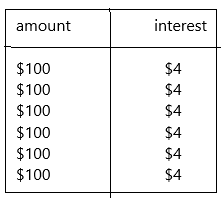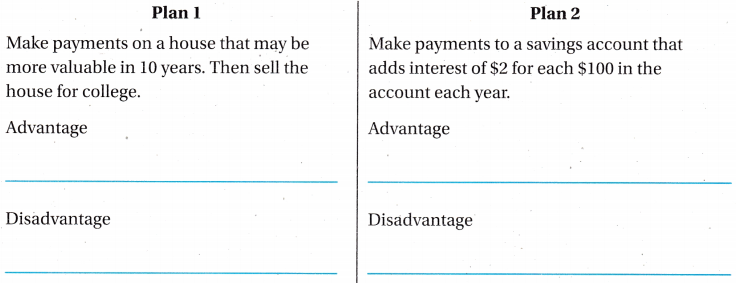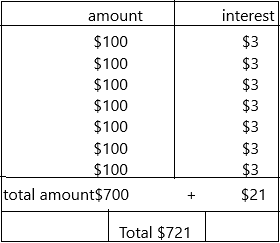Refer to our Texas Go Math Grade 4 Answer Key Pdf to score good marks in the exams. Test yourself by practicing the problems from Texas Go Math Grade 4 Lesson 18.3 Answer Key Savings Options.
Texas Go Math Grade 4 Lesson 18.3 Answer Key Savings Options
Essential Question
What are the advantages and disadvantages of different savings options?
Answer:
People save money for all different reasons. They also save money in different ways. You can keep your money at home or you can keep your money in a savings account at a bank. If you keep your money in a bank, you will earn interest, or additional money, for allowing the bank to use your money.
Unlock the Problem
Sammie is saving her money to buy a new tablet computer. She has saved $100 so far. Sammie can either put the S100 into a savings account at her bank or keep it at home in a safe location. help Sammie compare the advantages and disadvantages of saving her money at home or in a savings account.
Example 1 Advantages
Circle the phrases that apply.

Answer:
ADVANTAGES

Example 2 Disadvantages
Circle the phrases that apply.

Answer:
DISADVANTAGES:

How can an advantage sometimes also be a disadvantage? Explain.
Answer:
In savings people always see the safest side to put money on. For example, take share markets and mutual funds of course they are the best place to keep the money because if the shares rate increases automatically money doubles more than we keep. But there is also a disadvantage in share markets and mutual funds sometimes we lose money it totally depends on the market rate. Like share markets lot many things are there to run money for savings along with some risks also involved.
Example Compare Savings Plans
Natalie wants to buy a scooter for $100. Which bank has a better savings option?
Bank A: Put $10 a week of her allowance in a bank savings account.
The interest is $3 for every $100 in the bank.
Bank B: Put $10 a week of her allowance in a bank savings account.
The interest is $6 for every $100 in the bank.
After saving $10 a week for 10 weeks at Bank A, Natalie can have ___________ plus $ ___________ interest, or ___________.
After saving $10 a week for 10 weeks at Bank B, Natalie can have ___________ plus $ ___________ interest, or ___________.
So, ___________ has a better savings option for Natalie.
Answer:
After saving $10 a week for 10 weeks at Bank A, Natalie can have 10*10=$100 (For every $10, for 10 weeks $100) and for every $100 she gets $3 interest then she gets $100+$3=$103.
After saving $10 a week for 10 weeks at Bank B, Natalie can have 10*10=$100 (For every $10, for 10 weeks $100) and for every $100 she gets $6 interest then she gets $100+$6=$106.
So, bank B has a better savings option for Natalie. Because she is getting $3 more than bank A.
Math Talk
Explain why earning interest is an advantage.
Answer:
Interest is the cost of using somebody else’s money. When you borrow money, you pay interest. When you lend money, you earn interest.
Interest is additional money that must be repaid in addition to the original loan balance or deposit.
How much do you pay or earn in interest? It depends on:
1. The interest rate
2. The amount of the loan.
3. How long does it take to repay.
A higher rate or a longer-term loan results in the borrower paying more.
For example: If the lender gives $1000 with 5% interest to someone then the borrower should pay interest every month $1050. This can be calculated as 
Earning interest means getting more money.
Share and Show
Question 1.
Jacob needs $79 to buy a remote control car. Circle the advantage of Jacob saving his money in a savings account at his bank.

Answer:
The amount Jacob needs to buy a remote control car is $79
The question asked was the advantage of saving money in a bank account.
Of course, there is more benefit of saving money in the bank because they will pay interest up to a certain percentage which can be useful for the people. So I circled the first one.

Question 2.
Mary needs $120 to buy a new computer program. Circle the disadvantage of Mary saving her money at home.

Answer:
The amount Mary needs to buy a new computer program is $120
The question asked about the disadvantage of saving her money at home. In my view, keeping money at home is really disadvantageous because there is a chance of taking your money and spending it by others or else you only use it for another purpose.

Question 3
Write Math Give two or more reasons for saving your money in a savings account at a bank.
Answer:
The best way to ensure that you build wealth and avoid debt is to diligently plan and save as much money as possible for both future needs and desires. However, exactly how you handle your savings can depend greatly upon your financial habits. Some financial experts recommend setting up a simple savings account tied to your checking account.
1. You earn interest for your money. Although interest rates have been extremely low since 2007, with many savings accounts having an interest rate below 1%, you will still accrue interest over time with an account. That means you have more earning potential with your money compared to keeping it in a safe at home.
2. Your money kept safe Because your money is being held by a third party, it increases your personal safety. Not only does storing cash on your property make you a target for a potential robbery, but losses like that are not always covered by a homeowner’s or renter’s insurance policy. If there was a fire in your home or some other natural disaster, you could lose your cash as well. Keeping your cash in a savings account keeps you and your money safer.
3. You can open an account with very little money. Many savings accounts can be started for just $25. Some institutions may have an even lower limit, sometimes allowing an account to be opened for as little as $1. This gives you an opportunity to begin saving your money, even if you don’t have much to save at the start.
4. Savings accounts can provide automated bill payments. Many financial institutions allow bills to be paid automatically out of a savings account without being subjected to the withdrawal and transfer laws. This allows you to save time because you don’t need to manually pay every bill each month and you’re less likely to experience late fees because you missed or forgot a payment. Of course, you’ll need to have money in the account to pay the bill, but if you do, you’ll be able to maintain a better credit score over time.
5. You receive security. A savings account gives you the opportunity to put away cash in case you have an emergency situation. If you lose your job, for example, you’d be able to draw upon your savings account for your monthly expenses. Or if your water heater goes out, you could tap into your savings to purchase a new one. Think of a savings account as a small insurance policy that can help you maintain your current standard of living if something unfortunate occurs.
Problem Solving
Question 4.
Connect How is a parent giving you an extra quarter every time you save $2 like earning interest in a bank savings account?
Answer:
Yes, of course. I am earning interest $0.25 every time I save $2. In banks also they can pay interest if people deposit $25 only. But parents are paying every time I save. If I save $2 every day then I will get $2.25. How I got this $2.25 means: quarter means 1/4th that is equal to 0.25. I am saving $2 so 2+0.25=$2.25 every time. It is like earning interest in a bank savings account.
Question 5.

H.O.T. John thinks of three ways he could save the $20 he needs every 4 weeks to take guitar lessons. Which plan should he choose? Explain an advantage and disadvantage for each plan.

Answer:

Explanation:
Option 1 advantages: The usage of piggy bank is to store money. whenever he has money he can save on it and if he wants to take it out he can access it easily. And moreover, there is a locking system to the piggy bank so he can get money easily.
Option 1 disadvantages: The amount will be taken by someone and used it or he only uses it for another purpose.
Option 2 advantages: He can save money in the bank and they will pay interest to the amount he deposited and there is a lot of security.
Option 2 disadvantages: They typically have low-interest rates. With no lock-in period, there is potentially no incentive to commit to any minimum monthly deposits. The ability to access your savings at any time may increase the temptation to spend it. Plus, withdrawals are limited to six per month, so if you go over that limit, the fees can reduce the amount you’re saving.
Option 3 advantages: Actually it was a good deal and they pay $5 per hour.
He might get good savings if he works more. He can get some decoration skills too.
Option 3 disadvantages: If there is no equipment provided then it is very difficult to do lawns. And it is very time-consuming.
Question 6.
H.O.T. Multi-Step Marco charges $15 for every lawn he mows and $10 for every car he washes. He washes 2 cars and mows 3 lawns this week. He wants to spend $40 and put the rest in his savings account. How much money will Marco put in his savings account?
Answer: $25 he will save.
Explanation:
The amount Marco charges for each lawn=$15
The number of lawns he mows=3
The total amount he earns on lawns=$15*3=$45
The amount he charges for car washing=$10
The number of cars he washed=2
The total amount he earns on car washing=$10*2=20
The total amount he earned this week was $45+$20=$65.
The amount he wants to spend=$40
We need to calculate the amount he wants to save.
By math sentence, I can write as
the total amount he earned-amount he wants to spend=savings.
$65-$40=$25.
Savings=$25.
Question 7.
Apply What are some future things that you might save for by using a savings account at a bank?
Answer:
The savings account helps in various ways majorly in interest-earning and securing the future. The cash saved can be used to plan financial activities like education, vacation, and many others. When you save there is a duration it will require you to observe before you can begin withdrawing your cash, so it’s advisable to have various accounts like a checking account in case of emergencies. With a saving account, your unnecessary spending is cut off. This is what a savings account is used for mainly. Another useful purpose of a savings account is that it can be used in loan transactions like equated monthly instalments for homes, rent and investment plans which are systematic (SIPs).
Daily Assessment Task
Fill in the bubble for the correct answer choice.
Question 8.
Which statement is true about saving money in a bank savings account?
(A) You may lose money.
(B) You may end up with more money than the amount you deposit.
(C) You can never get your money out again.
(D) You have to pay the bank to keep your money there.
Answer: Option B is correct.

Explanation:
After depositing the money the bank will add the interest to the amount you deposit that’s why option B is correct.
Question 9.
Multi-Step Which statement is true about the savings options below?
Option X Beth puts $6 into a bank savings account every week for a year.
Option Y Beth puts $30 into a bank savings account every month for a year.
(A) She will have $52 more at the end of the year with Option Y.
(B) She will have the same amount of money at the end of the year.
(C) She will have $12 more at the end of the year with Option X.
(D) She will have $48 more at the end of one year with Option Y.
Answer: Option A is correct.

Explanation:
First of all, option Y is correct. he is saving $30 a month up to a year. Then yearly he is investing 30*12=$360. If $2 is added every month to his amount then he will get $54. According to the options definitely, he will get $52 more.
Question 10.
Barbara puts $22 a week for 30 weeks in her savings account at the bank. If she receives $4 interest for every $100 saved, how much money will Barbara have after the 30 weeks?
(A) $684
(B) $636
(C) $660
(D) $ 404
Answer: Option A is correct.

Explanation:
The amount barbara puts in her savings account every week is $22.
The number of weeks she saved her money=30
The interest she receives for every $100 is $4.
Now we need to calculate the amount she gets after 30 weeks.
Here she receives $4 interest for $100. For $600 she receives $24 interest. How can we calculate means, I will show in the below diagram:

She won’t get interest for an extra $60 because the bank will pay $4 interest for every $100 so we have to calculate for 6 -100’s.
600+24=624+60=$684. ($4*6times=$24). Extra 60 belongs to the total amount she deposited in the bank.
TEXAS Test Prep
Question 11.
Which of the following savings options will most likely allow you to reach a savings goal of $400 the fastest?
(A) Save $25 a week in a bank savings account.
(B) Save $25 a week in a drawer at home.
(C) Save $50 a week in a bank savings account.
(D) Save $50 a week by working odd jobs in your community.
Answer: Option C is correct.

Explanation:
In my point of view, if he chooses $50 a week to save in a bank account then within 8 weeks he can save $400. And moreover, for every $100 the bank will pay interest so definitely, you will get some extra amount after 8 weeks.
Texas Go Math Grade 4 Lesson 18.3 Homework and Practice Answer Key
Question 1.
Leon wants to buy a new skateboard. Circle the advantage of saving money for the skateboard in a savings account at his bank.

Answer:

Explanation: If he saves an amount in the savings account then he will get interest which is paid by the bank and he gets more money when he takes out the money which he can put more amount on a skateboard.
Question 2.
Circle the disadvantage if Leon buys the skateboard with money from his brother and then saves to pay his brother back with $4 interest for every $100.
![]()
Answer:

Explanation: If he borrow money from his brother and bought a skateboard for $400 and his brother asked to pay $4 interest for every $100 and he should pay $416 to his brother it is a loss. He is paying more amount to his brother than a skateboard. So this is the disadvantage.
Problem Solving
Question 3.
Emmy bought a doll and then sold it for more than she paid for it. How is that like earning interest on a bank savings account?
Answer: Exactly, it is like earning interest on a bank savings account. This can be explained by using an example, assume Emmy buy a doll for $200 and she is selling it for $35 extra means totally she sold it for $235. She is getting extra money like getting interest in a bank.
Question 4.
Sharon’s parents have 10 years to save for her college education. Give an advantage and disadvantage for each savings plan.

Answer:
Explanation of plan 1 advantages:
1. Appreciation: Owning a house provides you with a valuable asset and financial stability,” says Peter Vekselman, a real estate professional with Keller Williams’ Yates Estates in Georgia. By purchasing a home, you’ll have an asset that, in many cases, will appreciate in value over time. A $200,000 home today should see an increase in value to $250,000, $300,000, or more—depending on how long you plan to live there and market conditions, according to Vekselman. This makes your home one of the best investments you can make and a way to establish a financial foundation for future generations.
2. Tax benefits: The many expenses of owning a home—like property taxes and accounting costs—are tax-deductible. The largest deduction is generally the interest you pay on your mortgage, according to Liane, a broker associate with Florida’s Jamason Realty Group. “This allows you to keep more of your hard-earned money.
Disadvantages of plan 1:
Buyers will perceive your home negatively: If you are selling as-is, you can bet that most buyers will view your home negatively. They may still try to purchase it, but the moment they see the as-is they will assume that there is something seriously wrong with the property – something bad enough that you can’t afford to fix it, or that it is not fixable.
Explanation of plan 2 advantages:
Savings accounts will usually accrue interest over time: Although interest rates have been extremely low since 2007, with many savings accounts having an interest rate below 1%, you will still accrue interest over time with an account. That means you have more earning potential with your money compared to keeping it in a safe at home.
Disadvantages of plan 2:
Some financial institutions charge fees for their savings accounts: There may be monthly fees charged to your savings account for it to be maintained. To avoid this disadvantage, look for fee-free options at local banks or credit unions for the best results.
Lesson Check
Fill in the bubble completely to show your answer.
Question 5.
Multi-Step Amos wants to go on a trip in 4 months. He needs $600 for the trip. Which of the following savings options is the best way for him to save $600 in 4 months (16 weeks)?
(A) Save $100 a month in a bank and get $2.50 for every $100 saved.
(B) Save $50 a week in a bank and get $2 for every $100 saved.
(C) Save $30 a week and borrow the rest.
(D) Save $40 a week and get $3 for every $100 saved.
Answer: Option B is correct.

Explanation: In my point of view, if he saves $50 per week and he gets $2 extra every two weeks. That means he is earning $102 every two weeks. Like that he is earning $204 per month. Likewise, for 4 months $816. He is earning more money by saving $50 every week.
Question 6.
Which is a disadvantage of saving your money in a secret hiding place?
(A) You cannot always get to the money.
(B) The money will not earn interest.
(C) You will end up with more money than you saved.
(D) YOU can save more money.
Answer: Option B is correct.

Explanation: The main advantage of keeping your cash at a bank is you can save and invest it, whereas keeping money under the mattress doesn’t earn you any kind of interest. How much are we talking about? Well, if you keep $2,000 in cash for most of your adult life, instead of putting it in a 3% saving account, you will pass on $2,919 worth of interest after 30 years. That number gets bigger if you invest your $2,000 and get higher returns. Not allowing your cash to grow and compound can delay your retirement plans by several years, so you would have to work longer.
Question 7.
Vincent earned $36 on savings of $900.
What interest did he earn?
(A) $2 for every $100 saved
(B) $4 for every $100 saved
(C) $3 for every $100 saved
(D) $9 for every $100 saved
Answer: Option B is correct.

Explanation:
I = $ 36.00
Equation:
I = Prt
Calculation:
First, converting R percent to r a decimal
r = R/100 = 4%/100 = 0.04 per year,
then, solving our equation
I = 900 × 0.04 × 1 = 36
I = $ 36.00
The simple interest accumulated
on a principal of $ 900.00
at a rate of 4% per year
for 1 year is $ 36.00.
Question 8.
If you save $700 and earn $3 interest for every $100, how much money will you have in all?
(A) $721
(B) $703
(C) $730
(D) $7,021
Answer: Option A is correct.

Explanation: The explanation has shown in the below diagram.

Question 9.
Multi-Step Mel walked 4 dogs. She earned $15 each for each clog. She earned $12 an hour for babysitting for 3 hours. If she spends $42 on shoes and saves the rest, how much money will she save?
(A) $54
(B) $60
(C) $36
(D) $96
Answer: Option A is correct.

Explanation:
The total amount she earned for walking 4 dogs=$15*4=$60
The total amount she earned for babysitting for 3 hours=$12*3=$36
The total amount she earned on working=$60+$36=$96.
The amount she spends on shoes=$42
The amount she saved=$96-$42=$54.
Question 10.
Multi-Step Which statement is true about savings plans below?
Plan A: Save $15 in a savings account every week for 26 weeks.
Plan B: Save $50 in a savings account every month for 6 months.
(A) It would be better to save at home than to use either of these savings plans.
(B) At the end of the time, there will be the same amount of money using either plan.
(C) There will be more money in the savings account using Plan A.
(D) There will be more money in the savings account using Plan B.
Answer: Option C is correct.

Explanation:
If I save $15 every week for up to 26 weeks then I will get $390. For this $390 the bank will add the interest. At the end I can get more than $390.
Try More: